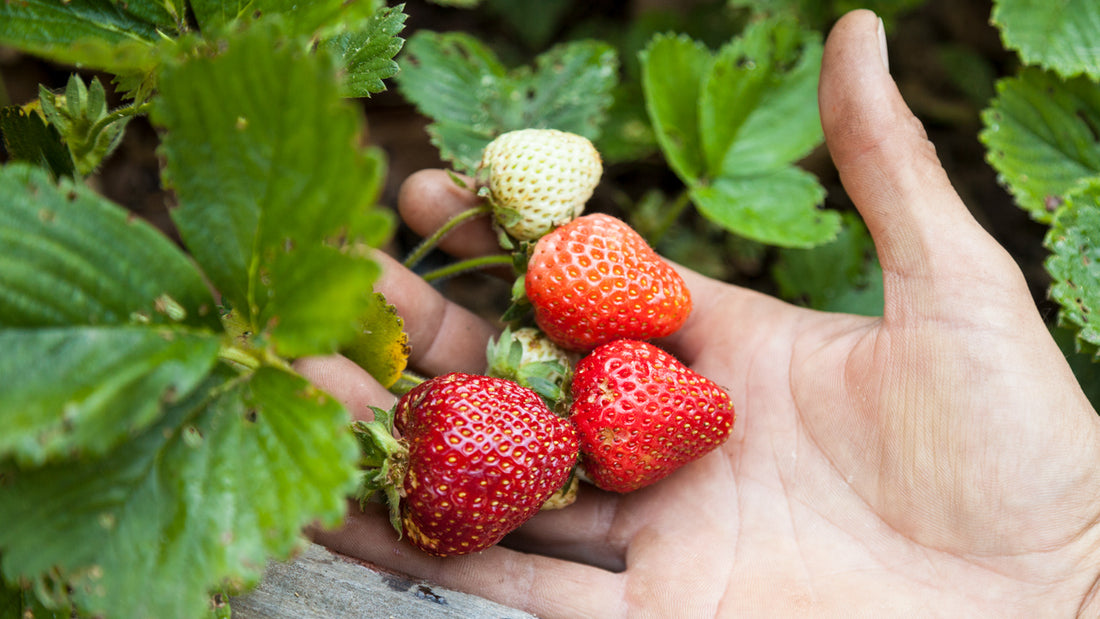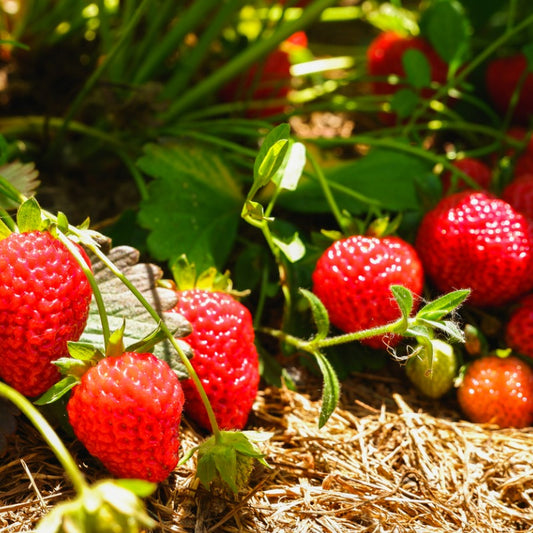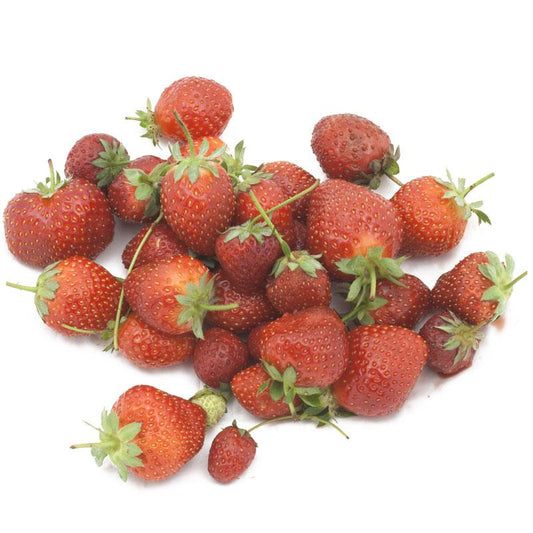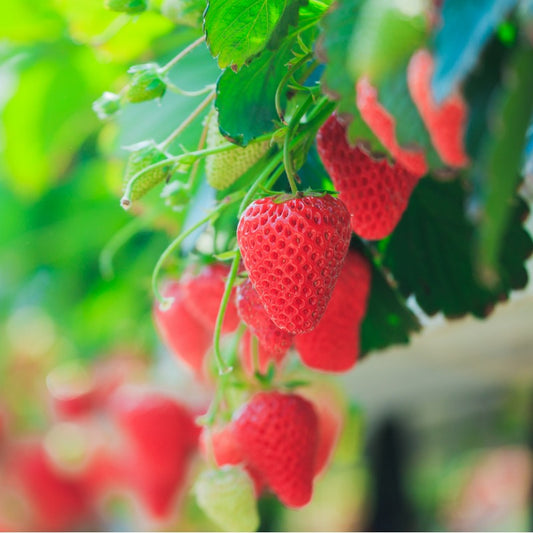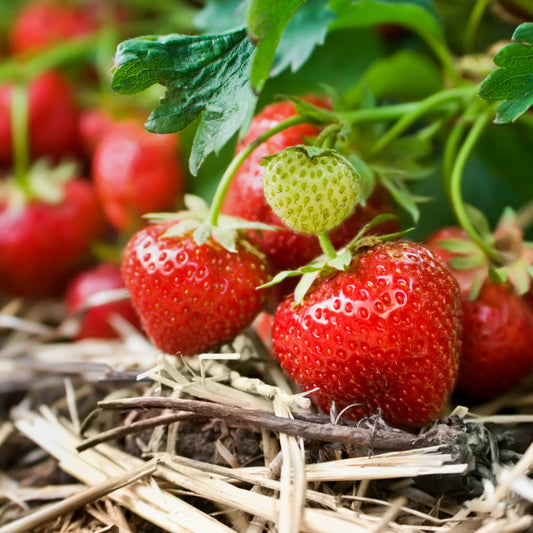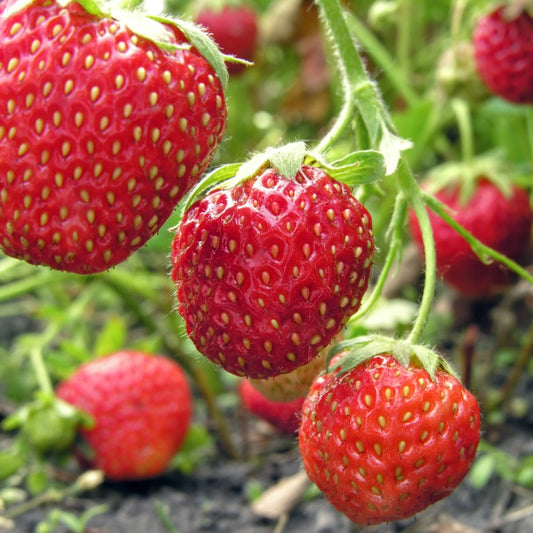The fundamental considerations and subtle nuances of growing and caring for strawberries are beyond the scope of this introduction to plant care. Please see our Resource Center where we offer additional instructional videos and articles, as well as our bookstore.
Heeling In
When your bare root strawberry plants arrive, open the plastic bags immediately. It is best to plant them right away, within a week of delivery, however if you cannot plant right away, you may “heel in” the plants. This protects them and keeps them alive (but still dormant) until you are able to plant them in their permanent spot.
Outdoors: To heel in bare root plants outside, pick a location that is shielded from wind. Dig a trench about twice as deep as the roots are long. Place in the hole roots side down and cover the roots with soil or sand and gently tamp down to avoid air pockets. Check the root area from time to time, keeping the soil moist.
Indoors: To heel in bare root strawberries indoors, whether due to snow or a frozen ground, choose a cool place like a root cellar, basement, or garage. It is important to choose a place where the temperature stays between 38°F and 45°F. This is important so the roots neither freeze, nor does the plant break dormancy. Place the roots in a container with soil or sand and be sure to keep the root area moist.
Soil Preparation
Strawberries require a loose, loamy, slightly acidic soil (pH 6.0–6.5) and full sun to achieve peak berry quality. They will tolerate a variety of soil conditions as long as they have adequate drainage. Prepare your strawberry beds by turning under high quality animal manure or plant residue-based compost. Compost composed of cedar or redwood is not an acceptable substitute for high quality compost.
Plant Care
When you are ready to plant, put the transplants in a bucket of water for a few minutes to rehydrate them. Keep them from drying out in the wind and sun. Dig each hole deep enough so that the transplant roots will not be bent or “j-rooted” when covered with soil. Prepare a soil cone at the bottom of the hole for the roots to rest upon when buried, keeping the roots as straight as possible.
Fill the hole with loose soil, keeping the upper crown bud at or slightly above the soil line. Plants will die if the crowns are completely covered. Once planted, strawberries will spread by producing “runners” where leaf cluster tips touch the ground.
Consider planting into weed fabric, especially the Everbearer or Day Neutral varieties. Give all strawberry varieties 1 inch of water per week, preferably using drip-type irrigation to minimize berry spoilage and keep the beds thoroughly weeded!
After the first frost, mulch beds with straw or agricultural fabrics (i.e. Floating Row Cover or Frost Blankets). Where snow remains on the ground throughout the winter, no mulching is required. When the ground warms in spring, remove any organic mulches.
Leave agricultural fabrics on until the first flowers appear; fabrics will speed growth but prevent pollination if left on during blossoming. Strawberries are prone to diseases caused by overly moist soil conditions and overcrowding.
Soil must be kept loose and well drained, plants must be properly spaced and ripe or moldy fruit picked daily. Snails and slugs can be a significant problem, but are controlled using traps and copper stripbarriers. Protect against birds with netting, scare balloons and flash tape.
June Bearers generally produce a single large crop in spring to early summer, as early as March in warmer regions such as Southern California and Florida. These june bearer strawberries are prolific producers for 3 to 4 weeks. They are a good choice for growers who want to limit their growing season for marketing or home processing reasons.
Since June Bearers spread their runners very rapidly, many growers consider the “matted row method” to be the most effective means of propagation. Rows are spaced 3-4’ apart with berry plants spaced at 18-24” apart. Plants are then allowed to “runner” freely in all directions, creating larger rows centered on the original mother plants. All flowers should be removed the first year of growth to allow for maximum runner spread.
Fruit production will occur the second year from the runners. A post-harvest regime of mowing plants down to 2” and tilling to within 10” of the original row will extend bed life for up to 3 years. Tilling up the original row, and leaving second or third generation plants to form new rows can extend bed life even longer.
Everbearers are most productive in northern areas where summer brings extended daylight hours. These varieties are not as prolific as June Bearers but are especially suitable for growers who wish to harvest an intermittent supply of berries in the summer. Also, you will get fruit the first year after planting, unlike June Bearers.
Many growers prefer to use the “Hill System,” for Everbearers when considering strawberry plant spacing. Space plants 12-15” apart in double or triple wide rows with 1.5-2’ between rows. Remove the first set of flowers after planting, and pull up all runners throughout spring and summer to increase fruit production.
Keeping these varieties trimmed of old, decaying foliage will allow better air circulation across the bed and result in high berry quality. Allow runners to develop in the second season to establish a new generation of plants; production of the original mother plants will decrease after the second season. After the second year’s harvest, pull out the mother plants, leaving only new plants spaced on the original bedding plan.
Day Neutral strawberries bear fruit from late winter until early Fall in temperate areas, and from early summer until the first frost in cold climates. These varieties are very prolific but are also more temperamental about their growing conditions than the other varieties. Day Neutral berries fare poorly against heat, dry soil and competition from weeds. Since Day Neutral varieties send out few runners, they should be cared for the same way as Everbearers (.ie. the “Hill System.")
Harvesting
It is important to practice proper “picking hygiene” when harvesting berries as disease can be easily spread if good fruit is handled after bad fruit. Always wash hands after removing moldy, deformed or over-ripe fruit and before harvesting your good berries.
Pick ripe strawberries by pinching through the stem above the fruit. Never pull on the berry itself. All strawberries will last several days under refrigeration.

